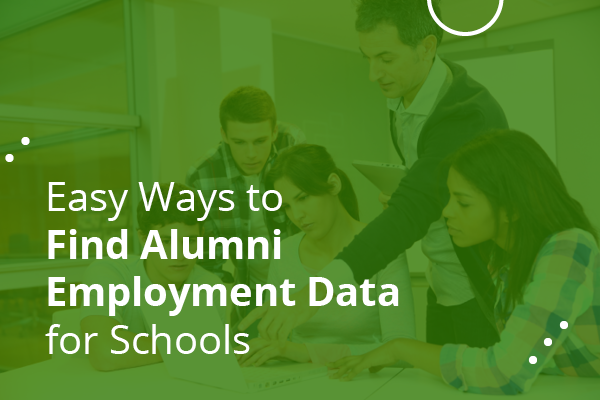4 Easy Ways to Find Alumni Employment Data for Schools
 Does your school have access to the alumni employment data you need to optimize your fundraising and engagement efforts?
Does your school have access to the alumni employment data you need to optimize your fundraising and engagement efforts?
Some of our favorite school fundraising ideas for institutions of all shapes and sizes have to do with effectively utilizing corporate philanthropy. Partnering with businesses both worldwide and in your community enables your team to collect increased funding, elevate mission awareness, and form lasting supporter relationships.
As a subcategory of corporate philanthropy, workplace giving puts charitability on a much more personal scale for donors—many of whom are previous graduates of your institution. Yet, in order to optimize your school’s corporate fundraising, you’ll need to know where your alumni are working. And in this guide, we’ll share four easy and effective ways you can do so:
Ready to dive in and uncover valuable information about your school’s previous students? Not to mention, these powerful data searching methods are not exclusive to alumni but can be used for all sorts of donors and prospects alike.
Let’s begin.
Alumni Employment Data Strategy #1: Email domain screening
Email domain screening is one of the simplest and most straightforward methods for collecting alumni employment information. All you have to do is take a look at your list of alumni contacts and scan for email addresses with corporate domains. For example, “ashley@homedepot.com” is more than likely employed by the Home Depot.
The downside to this approach is that you won’t be able to identify employers for any alumni who engage with your school using a personal email address. Thus, a large portion of your network will remain employer-unidentified unless you incorporate another strategy alongside your initial domain screening.
Alumni Employment Data Strategy #2: Employer appends
Employer appends are another common way to locate alumni employment information for individuals who are currently listed in your database without an associated employer.
This strategy typically involves outsourcing your data-seeking efforts to a third-party provider that specializes in data appends. There is a wide range of solutions to choose from, including companies that work exclusively with schools and other nonprofit organizations.
According to this Crowd101 guide on the subject,
“Data appending is the process of adding new information to your nonprofit’s database…to correct outdated, void, or inaccurate data or to supplement existing data with more information from external sources.
An employer append is a specific type of data append that finds where your donors work and what their job titles are.”
By utilizing employer appends, your school can quickly collect a ton of valuable information that can guide your alumni fundraising efforts without putting the brunt of the effort on your team to research and uncover the data themselves.
For the most exhaustive results, however, you should start with a solid baseline of information for each alumnus or donor. You will then share your existing data with the third-party employer appending company that will work to expand upon your original points, which can include as many of the following fields as possible:
- Unique ID number
- Individual’s name
- Mailing address (home, business, or both)
- Region (state, city, and country)
- Email address(es)
- Phone number(s)
- College or university (with class year and major/degree)
- Most recent gift amount
- Date of last donation
Once equipped with this data, the appending service scans it against publicly and privately available sources, which include government records, SEC filings, social media profiles, business registrations, and more.
At the conclusion of the appends process, you’ll likely be provided with employment information on approximately 20%-50% of your contacts—including the corporations they work for and the roles they fill. And luckily, employer appends providers have often reported higher success rates among donors for higher education institutions.
Keep in mind that the more information your school provides at the beginning of the process, the more likely you are to receive complete and accurate employer appends data.
Alumni Employment Data Strategy #3: Donation form fields
Another way to locate your alumni’s employment data is by seeking the information directly from the source—the alumnus themself. And one of the best ways to do so (particularly for your alumni donors) is by leveraging your donation form.
More than likely, you’re already asking donors for their basic information, including their name, address, email, phone number, and more. When you add an optional field for donors to enter employment information within your online donation form, you can uncover a lot of valuable data this way. Then, donors who are not wanting to provide this information at the time can simply bypass the optional field, and your team can work to locate their employment data using another method.
And luckily, the process can be made particularly simple when you utilize the best fundraising tools that offer customizable donation fields to collect the information you want.
Alumni Employment Data Strategy #4: Matching gift software
Our final approach leverages matching gift software, which assists schools like yours with the collection of ample alumni employment data along with a wide range of additional corporate fundraising functionalities as well.
A top matching gift provider such as 360MatchPro by Double the Donation can even streamline and automate multiple of the above approaches—including email domain screening and optional donation form fields.
This solution also offers automated donation follow-ups via email, which allows donors to interact with easy-to-use tools that enable them to research their employer and identify their matching gift eligibility. The information provided directly to donors is also stored in an online portal for schools and nonprofits to access for future data purposes.
What’s Next?
Thousands of companies are willing to give generously to schools and universities—especially when these contributions are made as part of a corporate matching gift program. Once you’ve collected the alumni employment data you need, begin incorporating targeted outreach to eligible individuals who would jump at the opportunity to support your school through their employer.
Learn more about the impact workplace giving can have on your school’s fundraising efforts with another SchoolMoney guide at https://www.schoolmoney.org/workplace-giving-and-school-fundraising/.



